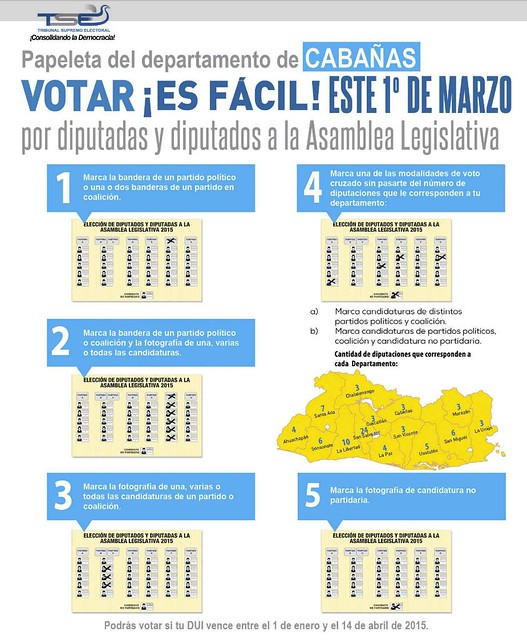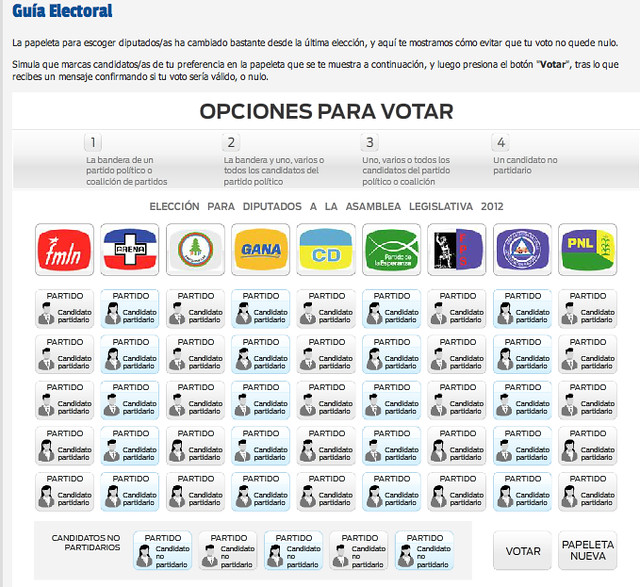Two noteworthy legislative elections are being held today, in El Salvador and the German state of Hesse. Both are of interest not only for what will happen today, but also for what they signal about upcoming elections.
El Salvador
Today Salvadorans go to the polls to elect the 84-seat Legislative Assembly and municipal posts throughout the country. The main thing to watch will be, how big are the gains for the FMLN (the ex-guerrilla leftist political party)? The party currently holds 32 seats (38%), and as I noted at the time of the last legislative elections, the country’s electoral politics has been in stasis since the negotiated end of the civil war in 1994. Will this be the election that breaks the stasis? Maybe, but there is a major caveat.
The last legislative election, in 2006, was held in the month of March. In fact, every legislative election back to 1952 has been held in March (except in 1960, when they waited till April). For that matter, every presidential election under the current constitution (1983) has been held in March (with a runoff in April or May, when needed). So why are Salvadorans going to the polls in January?
Presidential terms are five years and legislative terms three years, and so they will occur in the same year every 15 years. The last time elections to the two branches occurred in the same year–math whizzes will have recognized already that that was in 1994–they were on the same day in March. And therein lay a problem for the Salvadoran right.
The FMLN has been leading the polls in advance of this year’s presidential race for many months. To ward off a possible coattail effect, the center-right parties that control the legislature and presidency de-coupled the elections. So instead of a concurrent contest, El Salvador will have what I refer to as a “counterhoneymoon election” today. A legislative election shortly before a presidential election provides voters and party leaders with information, as CNN says in the opening paragraph of its news story on the elections:
El Salvador will elect more than 340 local and congressional officials Sunday, two months before the nation’s presidential election. But Sunday’s results could go a long way toward determining who that next president will be.
Well, actually, I think we already know–barring surprises–and as I suggested above, that’s precisely why these elections are today. But the general point is that these elections will either show the left as being more vulnerable than opinion polls and pundits suggest, or they will show the right what options it has to turn the tide by March.
It would be a surprise if the FMLN won a majority of seats today. It just might have had a shot at a majority (or close to it) had the legislative elections been left concurrent with the presidential race. But I would regard anything short of 39 seats for the FMLN as a victory for the right. Why 39? Because that is the highest seat total any party has won since the FMLN began competing in elections. More importantly, 39 was the total won by the long-ruling ARENA in 1994–in a concurrent election in which the ARENA presidential candidate won easily (49-25% in the first round, 68-32 in the runoff). That sort of presidential “pull” is exactly what ARENA wanted to prevent the FMLN from getting this time around.
Hesse
The results of this election are already in, and the Christian Democratic Union (the party of federal PM Angela Merkel) has won “handily.” DW reports:
Near-complete returns show Merkel’s CDU, lead by Roland Koch, narrowly increasing their share of the vote to around 38 percent. The SPD suffered dramatic losses, slumping more than 13 percent to a historic low of just over 23 percent. Among the smaller parties, the liberal Free Democrats took 16 percent of the vote, their best result in Hesse in more than 50 years. The Greens had 14 and the Left Party five percent respectively. The CDU says it now hopes to form a coalition government with the FDP. Voter turnout was low at just 60 percent.
This election is of greater interest than a state election normally would be for two reasons. First, federal elections are due later this year, and this is one of the last states to be voting before the national electorate will go to the polls.1 With both the CDU (accompanied by its Bavarian partner, the Christian Social Union) and its partner in the federal “grand coalition,” the Social Democrats (SPD), less than eager to continue the current arrangement, this state result is a potential bellwether.
The second item of interest in this election is that the state had been to the polls just under a year ago. In the 2008 election, the CDU and SPD each had won 42 seats (out of 110) and the Left (based on a union of ex-communists with leftist who had split from the SPD) had a breakthrough, winning 6 seats. The Greens had 9 and the FDP 11. This result meant no majority for either a center-left or a center-right coalition unless the center-left coalition included the Left party.
Following the 2008 election, coalition bargaining took some time and ultimately produced a formula in which the SPD and Greens would govern with the outside support of the Left. Never mind that the SPD leader, Andrea Ypsilanti, had explictly promised in her campaign not to work with the Left. It was the only possible majority unless the Greens, CDU and FDP would work together (which was also discussed, but failed). And then the SPD caucus vetoed Ypsilanti’s plan. That display of unwillingness of the SPD to set the precedent, in the old West Germany, of cooperation with the Left set the stage for this re-run (with a new SPD leader).2
The CDU has to feel pretty good about its chances in the federal elections after waiting out the center-left divisions in Hesse.
________
1. There will also be elections in Brandenburg, Saarland, Saxony, and Thuringia on 30 August. Federal parliamentary elections will be 27 September.
2. This summary is based primarily on my recollections of coverage over several months at DW-TV’s Journal. See also the brief summary from AFP.





